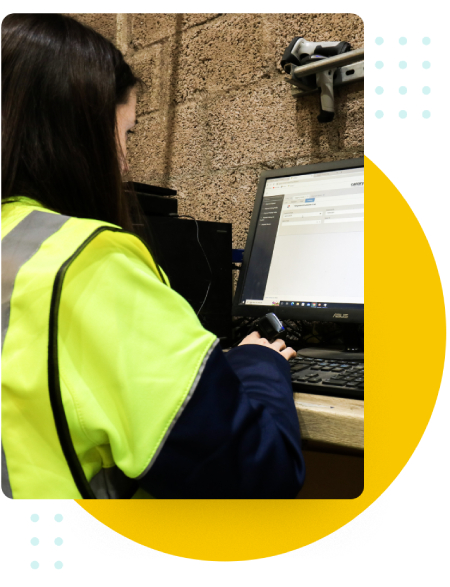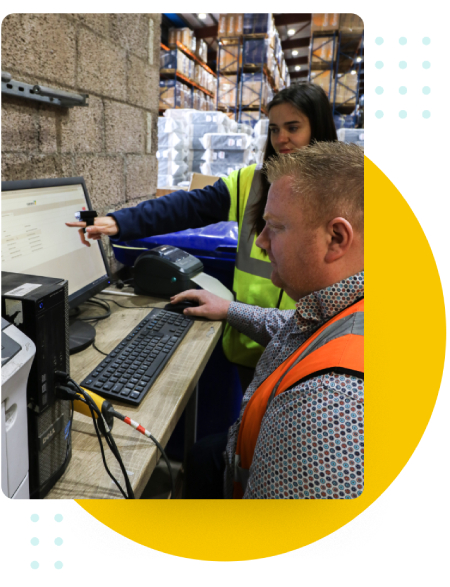Poor end-to-end visibility
Lack of visibility is one of the most common, recurring warehouse challenges that you may have to deal with as a 3PL business. Essentially, lack of visibility means that you are out of touch with your warehouse activity – you don’t know what’s going on within your warehouse/fulfilment centre, and hence are unaware of any problems that may cause the fulfilment process to bottleneck. It also means that you are not in control of your processes, which is likely to make it even harder for you to make the changes needed to ensure efficiency within the warehouse. All of this can cause the number of 3PL warehouse management challenges you need to deal with to increase.
Last-mile logistics problems
Last-mile logistics problem is another one of 3PL warehouse management challenges that can give warehouse managers and 3PL business-owners a tough time. “Last mile” refers to the final step of the fulfilment operation, i.e. the delivery. In simple words, the last-mile logistics problem is that shipping is expensive, and yet, customers expect free delivery. A good old paradox that it is, it is enough to cause 3PLs to worry about their operations as a whole. There are many aspects that feed into the last-mile logistics problem, such as failed deliveries, poor tracking, lack of transparency, unpredictable transit complications, and lack of a proper, holistic delivery infrastructure.
The Covid-19 pandemic made it even harder for businesses to manage the last-mile problem. This is because it came with the need for urgency – people wanted their Covid-19 lockdown supplies, and they needed them fast. What this resulted in was a pressure to speed up existing shipment procedures, and ensure that each aspect of last-mile logistics was seamless and aligned with the needs of the customer. This pressure has existed way beyond the lockdowns and Covid-19 chaos, and has left 3PLs grappling to adjust to the “new normal.” With most warehouses still relying on outdated delivery tools and technologies, the 3PL industry, for the most part, is still behind in the race in terms of ensuring the last-mile logistics are at par with needs of the modern post-covid customer.
Lack of scalability
No matter what the current size of your business is, all 3PL businesses want to grow. Unfortunately, scalability forms one of the most common 3PL warehouse management challenges, and therefore deserves your full attention. Scalability is impossible to achieve without a logistical framework, and a logistical framework, in today’s world, is entirely dependent on cutting-edge 3PL software solutions. If 3PL businesses keep using paper-based systems, scalability will remain one of the most difficult 3PL warehouse management challenges. This is because for scalability and growth, you need to prove to your existing customers that you are cut out for the race. This will involve a display of efficiency and productivity, which cannot be done with paper-based systems.
Scalability is increasingly becoming a problem as the world grows more interconnected. Because it is possible for end users to place their orders from all over the world, it means that businesses have to make it possible for themselves to ship all over the world as well. Third party logistics are complicated as it is, and with this element of globalisation added to the picture, 3PLs can really get a run for their money if they are planning to grow their business and get more customers on board. This, needless to say, is easier said than done and will require a lot of effort from a 3PL’s end.
High expectations
In general, customers of the 21st century display considerably more sophisticated in terms of their consumer behaviour, and hence have higher expectations that you must successfully tackle if you are planning to work towards long-lasting success as a 3PL. Some things that customers expect from businesses in 2022 include but are not limited to are: seamless cross-channel shopping, great environmental and social consciousness, technology-driven shopping experiences, fast and free shipping, and of course: flexible payments. Keep in mind that this is a exhaustive list – actually the extent of customer demands in 2022 is non-exhaustive and is likely to place even more requirements and responsibilities on business.
Speed is one of the greatest demands of the customer and bringing speed to the centre of your processes proves to be one of the most worrying 3PL warehouse management challenges. Customers today expect their order to be in their hands within 24 hours, and even though it is not possible, they want you to make it possible. Hence, the stakes are quite high in this area which can cause 3PLs some very major concerns. Any errors, defects, or mistakes can manifest into major setbacks, causing great delays and even greater dissatisfaction. This makes it crushingly difficult to satisfy the needs of the customer. However, if you are planning to stay in business for good then you must figure out a way to do it.
Workforce management
It is true that your workforce is your most important asset and with the right people on board, your 3PL experience can easily be improved in the best possible way. However, the main problem is that dealing with employees is not a piece of cake for any business, let alone a 3PL business that has to simultaneously tackle hundreds of 3PL challenges on a daily basis. Whether you have a big team or a small one, ensuring that task delegation is aligned with the overall goals and KPIs you have in place for the success of your business can prove to be tricky.
What’s more is that at times, it can be very hard to keep the morale of your employees high enough for them to actively participate in the warehouse activity taking place within a 3PL framework. Needless to say, working in a 3PL warehouse is not always easy and when having to deal with one problem after another, it is very likely that your employees may feel like they are not cut out for the job. Low employee morale will slow down processes and cause delays that 3PLs can simply not control. In essence, your employees empower the rest of your processes as well, so you can simply not afford for them to be disengaged from their jobs!





